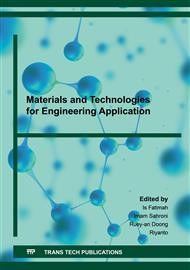[1]
S. M. Kanawade and R. W. Gaikwad, Removal of Methylene Blue from Effluent by Using Activated Carbon and Water Hyacinth as Adsorbent, Int. J. Chem. Eng App. 2 (2011) 317-319.
DOI: 10.7763/ijcea.2011.v2.126
Google Scholar
[2]
N. A. Oladoja, C. O. Aboluwoye, and Y. B. Oladimeji, Kinetics and Isotherm Studies on Methylene Blue Adsorption onto Ground Palm Kernel Coat, Turkish J. Eng. Env. Sci. 32 (2008) 303-312.
Google Scholar
[3]
Z. Haddadian, M. A. Shavandi, Z. Z. Abidin, A. Fakhru'l-Razi, and M. H. S. Ismail, Removal Methyl Orange from Aqueous Solutions Using Dragon Fruit (Hylocereusundatus) Foliage, Chem. Sci. Trans. 2 (2013) 900-910.
DOI: 10.7598/cst2013.439
Google Scholar
[4]
N. N. Nassar and A. Ringsred, Rapid Adsorption of Methylene Blue from Aqueous Solutions by Goethite Nanoadsorbents, Environ. Eng. Sci. 29 (2012) 790-797.
DOI: 10.1089/ees.2011.0263
Google Scholar
[5]
Y. S. Ho, McKay, and G., Pseudo-second Order Model for Sorption Processes, Pro. Biochem, 34 (1999) 451-465.
DOI: 10.1016/s0032-9592(98)00112-5
Google Scholar
[6]
T. E. Purbaningtias, B. Wiyantoko, P. Kurniawati, and M. K. Wardhani, Pengaruh Jenis Adsorben dan Waktu Kontak Terhadap Penurunan Bilangan Asam Minyak Nilam, Eksakta 14 (2014).
Google Scholar
[7]
R. Day, Underwood, and A. L, Quantitative Analysis, 4 ed. Englewood Cliffs, NJ: Prentice-Hall, (1982).
Google Scholar
[8]
A. A. Hoffmann, S. L. P. Dias, J. R. Rodrigues, F. A. Pavan, E. V. Benvenutti, and E. C. Lima, Methylene Blue Immobilized on Cellulose Acetate with Titanium Dioxide: An Application as Sensor for Ascorbic Acid,, J. Braz. Chem. Soc. 19 (2008) 5-6.
DOI: 10.1590/s0103-50532008000500020
Google Scholar
[9]
J. Rawlings, S. Pantula, and D. Dickey, Applied Regression Analysis: A Research Tool. (1998).
Google Scholar
[10]
M. J. Quina, J. C. M. Bordado, and R. M. Quinta-Ferreira, The influence of pH on the leaching behaviour of inorganic components from municipal solid waste APC residues, Waste Manage. 29 (2009) 2483-2493.
DOI: 10.1016/j.wasman.2009.05.012
Google Scholar
[11]
K. Komonweeraket, B. Cetin, A. H. Aydilek, C. H. Benson, and T. B. Edil, Effects of pH on the leaching mechanisms of elements from fly ash mixed soils, Fuel 140 (2015) 788-802.
DOI: 10.1016/j.fuel.2014.09.068
Google Scholar


